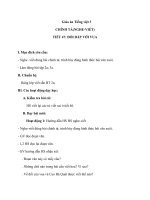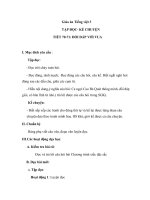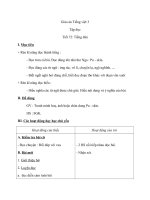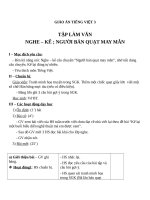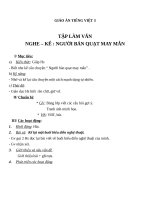giao an tieng anh 3 tuan 24 29
Bạn đang xem bản rút gọn của tài liệu. Xem và tải ngay bản đầy đủ của tài liệu tại đây (164.83 KB, 33 trang )
Week 24
Monday, February 26th , 2018
Review 2- period 93
I/ Aims:
- reviwe unit 4, 5, 6
- Speaking, listening, reading and writing skills
II/ Language contents:
1.Structure: review unit 4, 5, 6
2.Vocabulary: review unit 4, 5, 6
III/ Teaching Aids: picture
IV/ Steps of teaching:
1.Warm up and reviews
Play Slow reveal (see Teacher’s Book for instructions) with flashcards to revise
vocabulary
2. Presentations
- Practice and produce the structure seen in previous units
He’s a doctor.
She’s a nurse.
Where’s the teddy ? It’s in the swing….
3. Practice
Read. Tick the correct picture.
- Ask children look to the words. They point to the pictures as they look.
- Students do the exercise. Ask the class to chorally repeat the language once the
exercise is finished.
Match. Draw a line
- read and draw a lines.
Look and read. Put a tick ( √ ) or cross ( X ) in the box.
4. Production
- Do the exercise, and children join in the workbooks.
V/ Extension: ……………………………………………………………..
--------------------------------------------------------------------------------------------
Unit 7: Are these his trousers ?
Lesson One – Period 94
I/ Aims:
- Identifying clothes, Reading and speaking skills
II/ Language contents:
1.Structure: Is this….? Are these…?
2.Vocabulary: dress, socks, T- shirt, trousers, shorts
III/ Teaching Aids: My clothes flashcards 68-72, - Story poster 7
CD tracks 72-74
IV/ Steps of teaching:
1.Warm up and reviews:
- Sing In My Family to warm up the class.
2. Presentations:
Listen, point and repeat
- Use flashcards 68-72 to elicit and introduce the vocabulary. Hold up each card
in turn and say the word. Say them again, and children repeat after you. Hold up
again and say What’s this? for children to say the word.
- Ask children to listen to the words. They point to the pictures as they listen. Put
the flashcards around the room and as they listen one further time, they point to the
correct flashcards.
3. Practice
Listen and chant
- Students listen and point, and then listen and chant.
- Game: Play a guessing game with the class. Tell children they are going to
guess which flashcards you are holding up, without seeing them. If they name the
object within three guesses, they get one point. If they don’t, you get one point.
Hold up each flashcard in turn so that children can only see the back. Ask different
children What’s this? until the object has been guessed correctly. Keep a record of
the score on the board.
4. Production:
- Game: Ask five children to come to the front of the class. Tell each one that they
are wearing a wonderful new dress or t-shirt or socks. They are very proud of their
new clothes. Ask the class to say the chant from the course book again (page. 52).
When the children hear their item of clothing mentioned, they show it off to the
class (e.g. the girl with the dress might turn around and the child with the socks
might point to his/her feet).
V/ Extension: ……………………………………………………………..
Wednesday, February 28 th , 2018
Lesson One – Period 95
I/ Aims:
- Identifying clothes, reading and speaking skills
II/ Language contents:
1.Structure: This is his (t-shirt). Tim’s (trousers) are (blue). These are her (shoes).
2.Vocabulary: clothes, basket, her, his
III/ Teaching Aids: The Park flashcards 68 - 72, CD tracks 72 – 74, Story poster
7
IV/ Steps of teaching:
1.Warm up and reviews:
- Use the flashcards to elicit the vocabulary again for revision, and then focus
carefully on different sounds which may be difficult for the children (e.g. /sh/ in
shorts and t-shirt and /dr/ in dress)
2. Presentations:
Listen and read
- Use Story Poster 7 to present the story. Ask children to name as many things in
the picture as they can. Look at the story and ask children what is happening in
each box. Listen to the story as children follow with the poster, then listen again as
children follow in their books and point to the body parts. Ask simple
comprehension questions (Is it Billy’s t-shirt? Yes, it is to check understanding.
3. Practice
- Give flashcards 68-72 to different children. Ask them to stand up, one at a time.
They show their card for the class to shout out the word.
- PMB Activity: Give a PMB worksheet to each child and ask them to finish
drawing the pictures of clothes. Then they draw a line between the word and the
child. Put students into pairs and they point and say, using the target structure, This
is his t-shirt, or these are her shoes.
4. Production:
- Game: Play a guessing game with the class. Tell children they are going to
guess which flashcards you are holding up, without seeing them. If they name the
object within three guesses, they get one point. If they don’t, you get one point.
Hold up each flashcard in turn so that children can only see the back. Ask different
children What’s this? until the object has been guessed correctly. Keep a record of
the score on the board.
V/ Extension: ………………………………………………………………….
------------------------------------------------------------------------------------------------
Lesson Two – Period 96
I/ Aims:
- To answer questions with his and her, Writing and speaking skills
II/ Language contents:
1.Structure: Are these his/her (socks)?, Yes, they are. No, they aren’t
2.Vocabulary: My clothes flashcards 68-72
III/ Teaching Aids: My clothes flashcards 68-72
IV/ Steps of teaching:
1.Warm up and reviews
- Play Snap with the clothes flashcards. Say one of the clothes; show the
flashcards one by one. If the word is different to the picture, the children say the
word matching the picture. If it is the same they shout “Snap” and the first child to
say it can hold the flashcard for the rest of the game.
2. Presentations:
Listen to the story again and repeat. Act
- Point to the Story Poster 7 again and ask children to tell you what happened in the
story. Elicit the important words from the story and write them on the board
- Tell children to open their books to p.52 and play the recording again as children
follow in their books
- Put students in pairs and ask them to act out the story. Elicit what actions they
will need. Get a couple of strong pairs to act it out in front of the class.
3. Practice
Look and say
- Model the language and ask children to repeat the words and sentences. Focus on
the pronunciation. Drill the language.
4. Production
- Grammar Reference: Ask children to open their Class Books to p.75 and do the
Unit 7 Grammar activity to practice the target structure further.
V/ Extension: …………………………………………………………………..
Week 25
Monday, March 5 th , 2018
Lesson Two – Period 97
I/ Aims:
- To answer questions with his and her, Writing and speaking skills
II/ Language contents:
1.Structure: These are his/her (shorts). Are these his/her (socks)?
Yes, they are. No, they aren’t.
2.Vocabulary: My clothes flashcards 68-72
III/ Teaching Aids: My clothes flashcards 68-72
IV/ Steps of teaching:
1.Warm up and reviews
- Play Musical Cards. Play lively music, or the unit’s song. Hand the unit
flashcards out to different students in the class. They pass the cards to children
next to them around the class while the music is playing. Stop the music suddenly.
Ask the children who are holding the cards, What’s this? to elicit the words. Play
the music and the children keep playing the game.
2. Presentations:
Write
- Ask children to write his or her in the correct place in the sentences.
Point, ask and answer.
- Children point, ask and answer using the four pictures and the sentence parts as
prompts. Model with a strong student before they complete the exercise.
3. Practice
- Children do the exercise, looking at the pictures and matching the words his and
her before completing the sentences. Check as a class.
- Students do the exercise. They write Yes, they are or No, they aren’t after each
question. Put children in pairs and have them asking and answering the questions
together. Change the pairs and repeat.
4 Production:
Game: Stick the flashcards on the wall around the classroom. The children ask
together, What’s this? And you reply It’s a (dress). The children then run and
touch the correct flashcard.
V/ Extension: ………………………………………………………………………
Lesson Three – Period 98
I/ Aims:
- Identifying clothes,
II/ Language contents:
1.Structure: I put on my
2.Vocabulary: shoes, coat, hat
III/ Teaching Aids: - My clothes flashcards 68-75, - CD tracks 75-76
IV/ Steps of teaching:
1.Warm up and reviews
Use flashcards 73-75 to introduce the three new words, shoes, coat and hat. Hold
up each one and say the words for children to repeat.
2. Presentations:
Listen, point and repeat
- Stick the flashcards on the board and elicit the spelling from the class. Write the
words on the board under each card.
- Ask children to look at the pictures and play the first and second parts of the
recording as children point to the words. Play again for children to repeat the
words after the audio.
3. Practice
. Listen and sing
- Either use the song worksheet (without opening the Class Book) where children
listen and fill in the correct words, or do Exercise 2 in the Class Book. After either
activity, ask children to sing along with the CD and then sing together without the
CD audio
4. Production
- Cut and make: Give each child a copy of the PMB Cut and make worksheet.
Tell children to colour the clothes and then cut them out, as well as the doll. Show
children how to fold the tables so that the clothes fit on the doll. Children show
their dolls and make simple sentences such as, Her trousers are blue. Put up a
long piece of string in the classroom and give children some pegs so they can hang
their dolls on the clothes line and make further sentences about each other’s dolls.
V/ Extension: ……………………………………………………………..
Wednesday, March 7 th , 2018
Lesson Three – Period 99
I/ Aims:
- Listening and speaking skills
II/ Language contents:
1.Structure: I put on my ….
2.Vocabulary: shoes, coat, hat
III/ Teaching Aids:
- My clothes flashcards 68-75, - CD tracks 75-76
IV/ Steps of teaching:
1.Warm up and reviews
Play What have I got? Hold up one flashcard so that the class can only see the
back of it. Ask What is it? When the card has been guessed correctly, put it on the
board. Hold up a second card and repeat the procedure. Continue until all the
cards are on the board.
2. Presentations:
Sing and do
- Tell children they are going to sing the song again, but this time they are going to
do some actions as they listen and sing. Decide with the class what actions they
will do (e.g. putting on their socks, putting on their coats and hats etc...). Children
listen, sing and do the actions.
3. Practice
- Sing the song from Class Book p.54 again, with students doing the actions at the
same time. Sing a second time, with students at the front holding the three
flashcards (socks, shoes, and coat) and every time they hear their word they hold
the card up in the air.
- Children trace the clothes and write the words. They can check with a partner.
- Children complete the crossword using the words and pictures as prompts.
Check all the answers with the whole class, drilling the language as you do so.
4. Production
Game: Play Simon Says, using the target vocabulary. Say Put on your socks, put
on your coat etc... as well as using vocabulary from earlier units to recycle the
words. Explain that students just have to mime the actions. If you say ‘Simon
Says,’ before the instruction, children mime it. If you don’t say Simon Says, they
shouldn’t do it. If they do, they are out of the game.
V/ Extension: ……………………………………………………………..
---------------------------------------------------------------------------------------------------Lesson Four – Period 100
I/ Aims:
- First letter sounds – the alphabet
II/ Language contents:
1.Structure:
2.Vocabulary: all words from phonics cards 1-26
III/ Teaching Aids: Phonics cards 1 – 26 , CD Tracks 77
IV/ Steps of teaching:
1.Warm up and reviews
- Do the chant from page 45 to energize the class and revise the sounds that v, w, x,
y, and z make.
2. Presentations:
Listen and point . Listen and sing
- Use all the phonics cards for children to practice saying the letters of the
alphabet. Hold up the cards in a random order, showing only the pictures. Say the
name of the animal, person or object on the front of the card. Children call out the
name of the letter it begins with, e.g. Nurse? (n).
- Children listen, point and sing the alphabet song. Count off all the children in the
class as a letter of the alphabet and sing the song again. The children stand up
when they hear their letter in the song.
3. Practice
Write the letter
- Children write the missing letters. Check by singing the alphabet song slowly
together as children follow in their book.
4. Production:
- Put students in groups of four sure that the letters of the alphabet are divided up
among all the groups in the class. Give each group a large piece of card and tell
the children to draw the letters of the alphabet you have given them and pictures to
represent each letter. When they have finished, put the posters on the wall in the
correct order to form the whole alphabet. Ask children to come out the front and
read the alphabet from beginning to end and point to different pictures and and
give them some letters of the alphabet. Make ask the class to tell you the word.
V/ Extension: ……………………………………………………………..
Week 26
Monday, March 12 th , 2018
Lesson Four – Period 101
I/ Aims:
- Speaking and writing skills
II/ Language contents:
1.Structure:
2.Vocabulary: all words from phonics cards 1-26
III/ Teaching Aids: Phonics cards 1 – 26 , CD Tracks 77
IV/ Steps of teaching:
1.Warm up and reviews
- Give out the phonics cards to 26 children. Ask children to come to the front of
the class in the correct order to put the cards on the board. Do not confirm whether
the letters are in the correct place at this stage. If you have more than 26 children,
then the children who didn’t get cards can come up and make any changes to the
order that they think is necessary. Read the alphabet aloud slowly for the class to
check the order of the letters on the board.
2. Presentations
Point, ask and answer.
- Ask children to look at the two pictures and write the letters that each item in the
picture starts with. Check with their partner or in small groups.
- Children do exercise 1. They join the letters in the correct order to get out of the
maze. Put children into pairs to check each other’s work.
3. Practice
- Children do the exercise and write the letters of the alphabet in the correct order.
Check as with the class.
- Sounds Fun pair activity: Put children in pairs and give each either an A or B part
of the worksheet. They do not show their worksheet to their partner and sit back to
back. They read out their words in turn, and listen and tick the correct first letter
sounds they hear. Check as a class.
4. Production
Phonics relay: Put children into groups of six or eight and ask them to sit in a line
with their backs to the person behind them. Ask the last child in the line from each
group to come out the front. Take these children and whisper a letter to them (for
example, c). They go back to their group, sit down and trace the letter on the back
of the child in front of them. They then trace it on the next child’s back and it goes
on until it reaches the child at the front. The first child at the front to stand up and
shout out the letter correctly wins a point for their team. That child then goes to
the back and the activity can be repeated.
V/ Extension: ……………………………………………………………..
----------------------------------------------------------------------------------------------Lesson Five – Period 102
I/ Aims:
- Describing clothes, Reading skills
II/ Language contents:
1.Structure:
2.Vocabulary: Clothes,Try on,Team
III/ Teaching Aids: CD Track 78
IV/ Steps of teaching:
1.Warm up and reviews
- Energize the class by singing Every day! from page 54 to revise clothes
vocabulary
2. Presentations
Point to the clothes. Say the words..
- Ask children to look at the pictures on p.56 of the Class Book and predict what
they will read.
- Ask children to point to the different clothes members in the pictures. Elicit the
clothes vocabulary and write the words on the board.
3. Practice
- Children listen to the recording and follow the words in their book. Check
comprehension by asking simple questions: What colour does Mike like? (He
likes orange). Why does he like orange? (It is the colour of his football team).
4. Production
- Find someone who has…: Give each child a worksheet. Elicit or provide the
names of all the clothes and colours. Write the words on the board to help the
children. Model the sentence structure; Do you have a green t-shirt? Yes/No.
Then give children 5 minutes to stand up and walk around the room asking other
students if they have different coloured clothes. If a child says yes, then they write
their name next to that sentence on the worksheet. If they say no then they don’t
write their name. The idea is to finish the worksheet with as many different names
as possible. Ask children to tell you who has the clothes in those colours.
V/ Extension: ……………………………………………………………..
----------------------------------------------------------------------------------------------------
Wednesday, March 14th , 2018
Lesson Five – Period 103
I/ Aims:
- Describing clothes, Reading skills
II/ Language contents:
1.Structure:
2.Vocabulary: Clothes,Try on,Team
III/ Teaching Aids: CD track 78
IV/ Steps of teaching:
1.Warm up and reviews
- Play a miming game with all the clothes vocabulary. Mime once to demonstrate
the activity and ask students to guess the word. Put all the flashcards on the board.
Divide the class into groups of four. Give each child in the group a number. Tell
number ones to choose a word and to keep it secret. They then mime the word to
their group. The student who guesses it firsts gets a point. Then number twos do
the same thing and so on.
2. Presentations
Read again. Circle the wrong word and write the correct word.
- Do the exercise. Children circle the incorrect word in the sentence and write the
correct word. Check with the class.
- Role-play: Put children in pairs and ask them to act out the story. Ask two of the
stronger pairs to come out the front and act it out for the class.
3. Practice
- Ask children to open their Workbook and read the story again and write the
missing words using the words provided in the box. Children check with a partner
and then read the story as a whole class.
- Colour, point and answer: Give each child a copy of PMB Activity 7B worksheet.
Ask children to look and colour and then work in pairs to point, ask and answer
using the prompts next to the picture to help.
4. Production
- Put children in pairs again and ask them once again to look at the story. Elicit the
clothes words and the colours and put them on the board. Ask children to re-write
the story, changing those words. They can then act out their new story with the
new vocabulary. Put children in groups of six and ask each pair to act out their
story to the other two pairs in the group.
V/ Extension: ……………………………………………………………..
---------------------------------------------------------------------------------------------------Lesson Six – Period 104
I/ Aims:
- Describing clothes, Listening and speaking skills
II/ Language contents:
1.Structure: What colour is this? What colour are these?
2.Vocabulary: Clothes
III/ Teaching Aids: CD track 79, my clothes flashcard
IV/ Steps of teaching:
1.Warm up and reviews
- Play Whispers, using clothes vocabulary. Organize children into large groups.
Show a flashcard to the first child in each group. This child whispers the word to
the child next to him/her, and this continues around the group until the word
reaches the final child. The final child says the word aloud, and the first child holds
up the flashcard to see whether the word and the picture are the same.
2. Presentations
Listen and number.
- Children do exercise 1, listening and numbering the pictures.
Speaking
- Model the activity first with a strong student. Ask the child,What colour are these
trousers? The child answers, for example, They’re pink. Children then ask and
answer using the target structures with their partner. Swap and do the activity again
with a different partner.
3. Practice
- Personalisation: Ask children to work with a partner. They point to their own
clothes and ask their partner, What colour is (this skirt/this t-shirt etc…) and their
partner answers, for example, It’s blue. Swap partners and repeat.
4. Production
- Board game: Give each group of 4-6 children a copy of the board game.(Either in
colour or in black and white). They move around the board, saying the clothes as
they land on the squares with pictures of clothes. The winner is the first child to
reach the finish square.
V/ Extension: ………………………………………………………………
---------------------------------------------------------------------------------------------
Week 27
Monday, March 19 th , 2018
Lesson Six – Period 105
I/ Aims:
- Speaking and writing skills
II/ Language contents:
1.Structure: This is my…These are my….It’s…They’re….
2.Vocabulary: Clothes
III/ Teaching Aids: my clothes flashcard
IV/ Steps of teaching:
1.Warm up and reviews
- Spelling quiz: Put students into groups of four and give each group a spelling
quiz worksheet. Tell children they cannot open their Class Books or Workbooks,
and to think of a team name. Make one child the person responsible for writing the
words, but make sure they understand they all must help to spell. Read the words
on the second page (only for the teacher) one by one and students write the words.
Tell each group to swap their worksheets with another group. Check the spelling as
a class by asking volunteers to write the words on the board.
2. Presentations
Writing
- Ask children to do the Writing box at the bottom of p.57.They circle the‘s’ and
match the sentences. Copy the sentences onto the board and ask individual students
to come to the front and circle the ‘s.’
3. Practice
- Children do exercise 1, tracing the‘s’ and drawing more.
- Students rewrite the sentences using the contractions. Check with a partner and
ask 5
individual children to write the sentences on the board.
- Children circle their favourite clothes and write the colours. They then draw their
favourite clothes and write about them using the sentence prompts in the exercise.
Ask children to work in small groups and read their sentences to each other.
4. Production
- Give a copy of the Values worksheet to each student. Ask them to draw the
different clothes in the appropriate place in the table, choosing whether the clothes
are for warm or cool weather. Pre-teach warm and cool if the children don’t know
the meaning of the words. Then children read and colour the pictures of the
children and check together with the class.
V/ Extension: ……………………………………………………………..
--------------------------------------------------------------------------------------------
Review - period 106
Wednesday, March 21th , 2018
Unit 8: Where’s Grandma?
Lesson One – Period 1107
I/ Aims:
-Identifying different places in a home, Reading and speaking skills
II/ Language contents:
1.Structure: Where’s...
2.Vocabulary: kitchen, livingroom, diningroom, bedroom, bathroom, garden
III/ Teaching Aids: My house flashcards 76 - 81, - Story poster 8 CD tracks 80 82
IV/ Steps of teaching:
1.Warm up and reviews:
- Sing Every Day to warm up the class.
2. Presentations:
Listen, point and repeat
- Use flashcards 76-81 to elicit and introduce the vocabulary. Hold up each card in
turn and say the word. Say them again, and children repeat after you. Hold up
again and say What’s this? for children to say the word.
- Ask children to listen to the words. They point to the pictures as they listen. Put
the flashcards around the room and as they listen one further time, they point to the
correct flashcards
3. Practice
Listen and chant
- Students listen and point, and then listen and chant.
- Game: Play a guessing game with the class. Tell children they are going to
guess which flashcards you are holding up, without seeing them. If they name the
